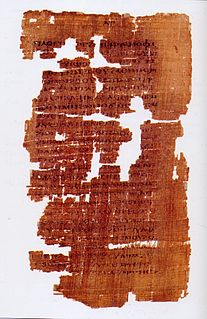
Gnosticism is a collection of religious ideas and systems which coalesced in the late 1st century AD among Jewish and early Christian sects. These various groups emphasized personal spiritual knowledge (gnosis) above the orthodox teachings, traditions, and authority of religious institutions. Gnostic cosmogony generally presents a distinction between a supreme, hidden God and a malevolent lesser divinity who is responsible for creating the material universe. Consequently, Gnostics considered material existence flawed or evil, and held the principal element of salvation to be direct knowledge of the hidden divinity, attained via mystical or esoteric insight. Many Gnostic texts deal not in concepts of sin and repentance, but with illusion and enlightenment.

Fractal art is a form of algorithmic art created by calculating fractal objects and representing the calculation results as still digital images, animations, and media. Fractal art developed from the mid-1980s onwards. It is a genre of computer art and digital art which are part of new media art. The mathematical beauty of fractals lies at the intersection of generative art and computer art. They combine to produce a type of abstract art.

The Nag Hammadi library is a collection of early Christian and Gnostic texts discovered near the Upper Egyptian town of Nag Hammadi in 1945.

Visionary art is art that purports to transcend the physical world and portray a wider vision of awareness including spiritual or mystical themes, or is based in such experiences.

Alex Grey is an American visual artist, author, teacher, and Vajrayana practitioner known for creating spiritual and psychedelic paintings. He works in multiple forms including performance art, process art, installation art, sculpture, visionary art, and painting. He is also on the board of advisors for the Center for Cognitive Liberty and Ethics, and is the Chair of Wisdom University's Sacred Art Department. He and his wife Allyson Grey are the co-founders of The Chapel of Sacred Mirrors (CoSM), a non-profit organization in Wappingers Falls, New York.
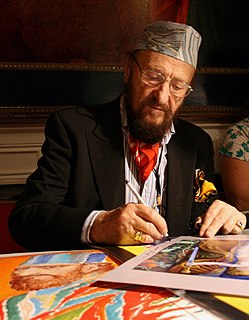
Ernst Fuchs was an Austrian painter, draftsman, printmaker, sculptor, architect, stage designer, composer, poet, and one of the founders of the Vienna School of Fantastic Realism. In 1972, he acquired the derelict Otto Wagner Villa in Hütteldorf, which he restored and transformed. The villa was inaugurated as the Ernst Fuchs Museum in 1988.
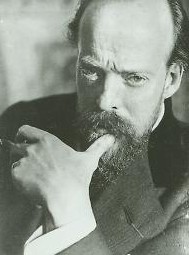
Carlos Schwabe was a Swiss Symbolist painter and printmaker.

The Gospel of Mary is a non-canonical text discovered in 1896 in a 5th-century papyrus codex written in Sahidic Coptic. This Berlin Codex was purchased in Cairo by German diplomat Carl Reinhardt.

Erik Davis is an American writer, scholar, journalist and public speaker whose writings have ranged from rock criticism to cultural analysis to creative explorations of esoteric mysticism. He is perhaps best known for his book Techgnosis: Myth, Magic and Mysticism in the Age of Information, as well as his work on California counterculture, including Burning Man, the human potential movement, and the writings of Philip K. Dick.
The Sethians were one of the main currents of Gnosticism during the 2nd and 3rd century CE, along with Valentinianism and Basilideanism. According to John D. Turner, it originated in the 2nd century CE as a fusion of two distinct Hellenistic Judaic philosophies and was influenced by Christianity and Middle Platonism. However, the exact origin of Sethianism is not properly understood.

The Gospel of Truth is one of the Gnostic texts from the New Testament apocrypha found in the Nag Hammadi codices ("NHC"). It exists in two Coptic translations, a Subakhmimic rendition surviving almost in full in the first Nag Hammadi codex and a Sahidic in fragments in the twelfth codex.
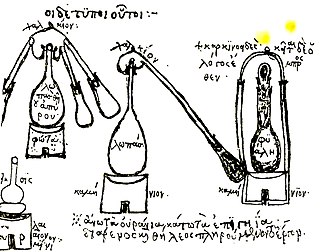
Zosimos of Panopolis was a Greco-Egyptian alchemist and Gnostic mystic who lived at the end of the 3rd and beginning of the 4th century AD. He was born in Panopolis, and flourished ca. 300. He wrote the oldest known books on alchemy, which he called "Cheirokmeta," using the Greek word for "things made by hand." Pieces of this work survive in the original Greek language and in translations into Syriac or Arabic. He is one of about 40 authors represented in a compendium of alchemical writings that was probably put together in Constantinople in the 7th or 8th century AD, copies of which exist in manuscripts in Venice and Paris. Stephen of Alexandria is another.
Gnosticism refers to a collection of religious groups originating in Jewish religiosity in Alexandria in the first few centuries CE. Neoplatonism is a school of Hellenistic philosophy that took shape in the 3rd century, based on the teachings of Plato and some of his early followers. While Gnosticism was influenced by Middle Platonism, neoplatonists from the third century onward rejected Gnosticism. Nevertheless, Alexander J. Mazur argues that many neoplatonic concepts and ideas are ultimately derived from Sethian Gnosticism during the third century in Lower Egypt, and that Plotinus himself may have been a Gnostic before nominally distancing himself from the movement.
Gnosticism in modern times includes a variety of contemporary religious movements, stemming from Gnostic ideas and systems from ancient Roman society. Gnosticism is an ancient name for a variety of religious ideas and systems, originating in Jewish-Christian milieux in the first and second century CE.
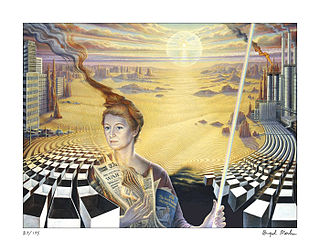
Brigid Marlin is an American artist based in Hertfordshire, UK. She studied in Dublin, Montreal, New York, Paris and Vienna where, under the guidance of the Austrian artist Ernst Fuchs, she learned the oil and egg tempera technique (Mischtechnik) of the Flemish and Italian Renaissance painters Jan van Eyck and Giovanni Bellini. In 1961 she founded the ins-cape group, which subsequently became the Society for Art of Imagination.

Amanda Sage is an American painter who has studied and worked in Vienna, Austria and Los Angeles, California. She trained and worked with Ernst and Michael Fuchs, a classical artist who taught her Mischtechnik. Through Fuchs she came to know other Visionary artists with whom she has worked, exhibited and co-founded the Academy of Visionary Art in Vienna and the Colorado Alliance for Visionary Art. Sage is a lecturer, teacher, and live artist with works in international galleries and museums.

Bernard Dumaine is a French artist best known for his work in photorealism and surrealism styles and for his background designs for television cartoons. He works in a variety of media, including oil paints, acrylic paints, graphite pencil, digital painting, digital collage, and video.

The Sacred Mushroom and the Cross: A Study of the Nature and Origins of Christianity Within the Fertility Cults of the Ancient Near East is a 1970 book about the linguistics of early Christianity and fertility cults in the Ancient Near East. It was written by John Marco Allegro (1923–1988).
Ulf Langheinrich is a visual artist and composer.
His work is mainly concerned with non-narrative environments and performances focusing on a specific approach to time, space and body. Since 2016 he is the Artistic Director of the International Festival for computer based art CynetArt in Dresden, Germany.
Wolf-Peter Funk was a historian of religion and Coptologist known for his pioneering studies on Gnosticism, Manichaeism, and Coptic manuscripts such as the Nag Hammadi library.













